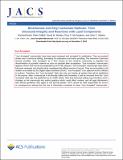Bicarbonate and alkyl carbonate radicals : structural integrity and reactions with lipid components
Date
30/12/2015Metadata
Show full item recordAbstract
The elusive neutral bicarbonate radical and the carbonate radical anion form an acid/conjugate base pair. We now report experimental studies for a model of bicarbonate radical, namely methyl carbonate (methoxycarbonyloxyl) radical, complemented by DFT computations at the CAM-B3LYP level applied to the bicarbonate radical itself. Methyl carbonate radicals were generated by UV irradiation of oxime carbonate precursors. Kinetic EPR was employed to measure rate constants and Arrhenius parameters for their dissociation to CO2 and methoxyl radicals. With oleate and cholesterol lipid components methyl carbonate radicals preferentially added to their double bonds; with linoleate and linolenate substrates abstraction of the bis-allylic H-atoms competed with addition. This contrasts with the behavior of ROS such as hydroxyl radicals that selectively abstract allylic and/or bis-allylic H atoms. The thermodynamic and activation parameters for bicarbonate radical dissociation, obtained from DFT computations, predicted it would indeed have substantial lifetime in gas and nonpolar solvents. The acidity of bicarbonate radicals was also examined by DFT methods. A noteworthy linear relationship was discovered between the known pKa's of strong acids and the computed numbers of microsolvating water molecules needed to bring about their ionization. DFT computations with bicarbonate radicals, solvated with up to eight water molecules, predicted that only 5 water molecules were needed to bring about its complete ionization. On comparing with the correlation, this indicated a pKa of about -2 units. This marks the bicarbonate radical as the strongest known carboxylic acid.
Citation
Buehl , M , DaBell , P , Manley , D , McCaughan , R & Walton , J C 2015 , ' Bicarbonate and alkyl carbonate radicals : structural integrity and reactions with lipid components ' , Journal of the American Chemical Society , vol. 137 , no. 51 , pp. 16153–16162 . https://doi.org/10.1021/jacs.5b10693
Publication
Journal of the American Chemical Society
Status
Peer reviewed
ISSN
0002-7863Type
Journal article
Description
The authors thank EaStCHEM for funding.Collections
Items in the St Andrews Research Repository are protected by copyright, with all rights reserved, unless otherwise indicated.

